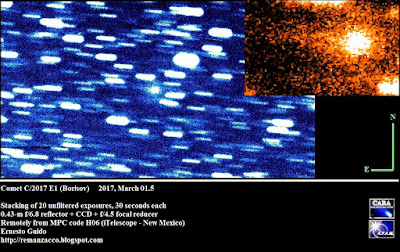During the month of June 2017, 6 new comets were discovered and there were 4 comet recoveries. "
Current comet magnitudes" & "
Daily updated asteroid flybys" pages are available at the top of this blog (or just click on the underline text here). See below for the "Other news" section.
The dates below refer to the date of issuance of CBET (Central Bureau Electronic Telegram) which reported the official news & designations.
- Comet Discoveries
Jun 01 Discovery of P/2017 K3 (GASPAROVIC)
Jun 01 Discovery of C/2017 K5 (PANSTARRS)
Jun 01 Discovery of C/2017 K6 (JACQUES)
Jun 23 Discovery of C/2017 M3 (PANSTARRS)
Jun 23 Discovery of C/2017 M4 (ATLAS)
 |
| Comet C/2017 K4 (ATLAS) - E. Guido |
- Comet Recoveries
Jun 06 Recovery of P/2000 S1 (SKIFF) as P/2017 L1
Jun 06 Recovery of P/2004 T1 (LINEAR-NEAT) as P/2017 M2
 |
| Comet P/2009 S2 (McNAUGHT) - Guido & Sostero |
- Other news
Jun 5 CBET 4401 reports that minor planet (9972) MINORUODA is a binary system with an orbital period of 22.89 +/- 0.01 hr. The primary shows a period of 3.4221 +/- 0.0002 hr and has a lightcurve amplitude of 0.11 mag at solar phases 10-14 degrees, suggesting a nearly spheroidal shape. Mutual eclipse/occultation events that are 0.06- to 0.13-magnitude deep indicate a lower limit on the secondary-to-primary mean-diameter ratio of 0.24.
Jun 13 CBET 4403 provide the following update by Jenniskens & Lyytinen on expected meteor activity from long-period comet C/2015 D4, now that an improved comet orbit is available (cf. CBET 4127). Based on an orbit for C/2015 D4 calculated by G. V. Williams from 43 observations spanning 2015 Feb. 23-Oct. 15 (cf. MPEC 2015-U54), the position of the one-revolution dust trail was calculated for the period 1996-2070. Results show that the dust trail will be in the earth's path on 2017 July 29d00h22m UT (solar longitude 125.858 deg), when the earth passes the center of the trail at a relative distance of only r - Delta = +0.0006 AU; the earth will thus pass inside the comet's orbit at a time when the comet has just passed perihelion, both favorable circumstances for detecting meteors. Meteors are expected from geocentric R.A. = 79 deg, Decl. = -32 deg, with geocentric velocity 45.9 km/s.
Jun 20 Images of asteroid
6 Hebe taken using SPHERE instrument on ESO ’s Very Large Telescope and related research paper
http://bit.ly/2tnC9hR
 |
| Credit: ESO/M. Marsset |
Jun 22 New paper on Arxiv by D. Nesvorny et al.: "
Origin and Evolution of Short-Period Comets". In the panel below, extracted from the paper, the orbital distribution of known SPCs. The thin lines show the division between between ECs and NICs (panel b; TJ = 2).
 |
| Credit: Nesvorny et al. |
Jun 24 CBET 4409 reports that comet C/2015 ER61 (PANSTARRS) has evidently experienced a splitting: a companion fragment (denoted 'B') was reported by E. Bryssinck (Kruibeke, Belgium) from CCD images taken by F.-J.Hambsch (Mol, Belgium) and himself on June 13, 15, and 16 remotely with a 0.4-m f/6.8 reflector (both unfiltered and with a Bessel R filter) at the private "ROAD Observatory" located at San Pedro de Atacama, Chile; Bryssinck noticed a change over a couple of days in the shape of the nuclear condensation, followed by the appearance of a possible nuclear fragment inside the coma and tail. On June 13.41 UT, seven exposures show a very faint fragment located 12".3 from the main nuclear condensation in p.a. 243 degrees with a diameter of 8" (magnitude R = 16.5 in an aperture of diameter 5".4). Seven images taken on June 15.42 show the very faint fragment 13".0 from the main condensation in the same direction and with magnitude R = 16.6 in the same-sized aperture. Nine images taken on June 16.41 show component B at size 8".8 (with R = 16.6 in a 5".4 aperture) and located 13".4 from component A in p.a. 248 deg. Component B is difficult to see due its small distance from component A and to its location within the tail.
by Ernesto Guido

















































